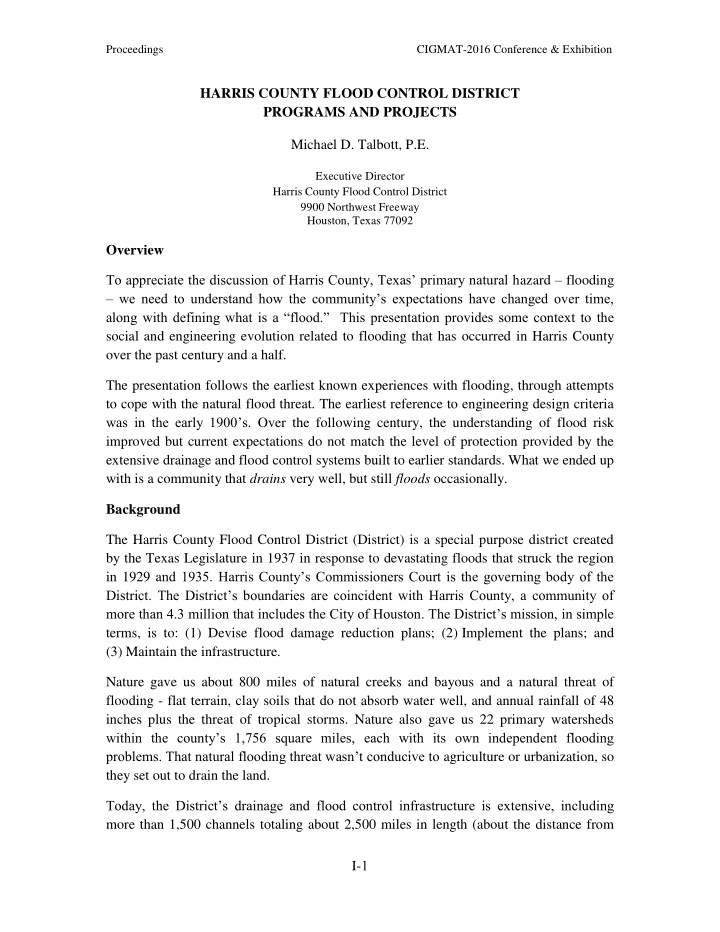



Proceedings CIGMAT-2016 Conference & Exhibition HARRIS COUNTY FLOOD CONTROL DISTRICT PROGRAMS AND PROJECTS Michael D. Talbott, P.E. Executive Director Harris County Flood Control District 9900 Northwest Freeway Houston, Texas 77092 Overview To appreciate the discussion of Harris County, Texas’ primary natural h azard – flooding – we need to understand how the community’s expectations have changed over time, along with defining what is a “flood.” This presentation provides some context to the social and engineering evolution related to flooding that has occurred in Harris County over the past century and a half. The presentation follows the earliest known experiences with flooding, through attempts to cope with the natural flood threat. The earliest reference to engineering design criteria was in the early 1900’s. Over the following century, the understanding of flood risk improved but current expectations do not match the level of protection provided by the extensive drainage and flood control systems built to earlier standards. What we ended up with is a community that drains very well, but still floods occasionally. Background The Harris County Flood Control District (District) is a special purpose district created by the Texas Legislature in 1937 in response to devastating floods that struck the region in 1929 a nd 1935. Harris County’s Commissioners Court is the governing body of the District. The District’s boundaries are coincident with Harris County, a community of more than 4.3 million that includes the City of Houston. The District’s mission, in simple terms, is to: (1) Devise flood damage reduction plans; (2) Implement the plans; and (3) Maintain the infrastructure. Nature gave us about 800 miles of natural creeks and bayous and a natural threat of flooding - flat terrain, clay soils that do not absorb water well, and annual rainfall of 48 inches plus the threat of tropical storms. Nature also gave us 22 primary watersheds within the county’s 1,756 square miles, each with its own independent flooding problems. That natural flooding threat wasn’t conducive to agriculture or urbanization, so they set out to drain the land. Today, the District’s drainage and flood control infrastructure is extensive, including more than 1,500 channels totaling about 2,500 miles in length (about the distance from I- 1
Proceedings CIGMAT-2016 Conference & Exhibition Los Angeles to New York). The flooding problems in the community are severe, with several hundred thousand homes and businesses in the identified flood plain (not all flooding areas are mapped yet), and projects to reduce the risk are estimated to cost several billion dollars. The District’s Mission Statement is: “Provide flood damage reduction projects that work, with appropriate regard for community and natural values.” This balancing act is a continual challenge in the third most populous county in the United States, and achieving needed flood risk reduction within financial limitations is the major component of the District’s commitment to make every taxpayer dollar count. Evolution of Community Flood Standards Two- thirds of the County’s 2,500 miles of channels were co nstructed where no channel existed before. Most of the original 800 miles of natural creeks and bayous have been modified significantly as well for flood protection. But what was the criteria for these systems over time? How did we get there over the past century and a half? What did the engineers know? What was the understanding of “flooding?” What were the public’s expectations? The presentation covers the evolution of community flood standards: Starting with early accounts from travelers heading west from Houston through standing water for days. Drainage districts in the early 1900s documented their objective of draining the land for “large” rainfall events. It was not uncommon for the new channels to be laid out as “4 feet wide and 4 feet deep.” In the 1930s, the US Army Corps of Engineers introduced the “Standard Project Flood” for the primary flooding sources in the County, which intends to design for the largest rain that should reasonably occur for an area. In the 1940s, a public petition was filed with Harris County Commissioners Court to support selling bonds for flood protection. The criteria cited in the petition called for systems to be designed to handle “4 inches of rain in 24 hours.” In the 1960s, the City of Houston, Harris County and the Harris County Flood Control District undertook “Comprehensive Studies of Drainage for Metropolitan I- 2
Proceedings CIGMAT-2016 Conference & Exhibition Houston.” The studies introduced a sliding frequency scale for design based on drainage area, with a maximum 25-year level of protection. Meanwhile, the Corps of Engineers” criteria underwent changes in project development based on economics and environmental considerations. In the early 1970s, the concept of the 100-year or (1% chance) storm and flood was introduced to the community with the advent of the National Flood Insurance Program (NFIP). It wasn’t until the 1980s that the first detailed floodplain studies, design criteria, hydrologic methodology, general application of stormwater detention, extensive stream and rainfall gage network developed, Federal National Economic Development standards were adopted. In the 2000s, new flood studies were developed using the latest technology to produce more detailed NFIP Flood Insurance Rate Maps. Throughout the evolution of the physical drainage and flooding infrastructure in the County, systems were built to the standards of the time. Right of way was acquired, infrastructure constructed and land development occurred adjacent to the systems. As community standards and expectations for flood protection evolved, the challenge has been to attempt to retrofit systems that were never built to today’s expectations. I- 3
Recommend
More recommend